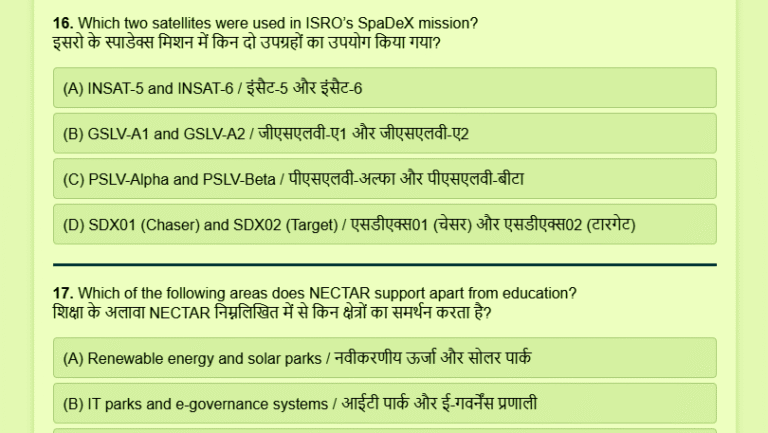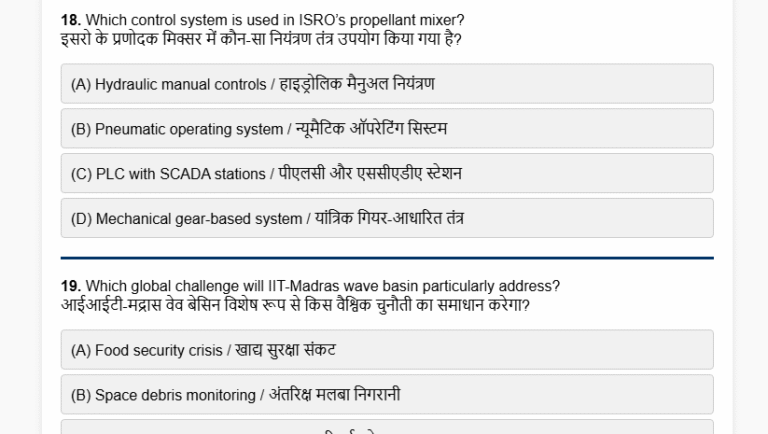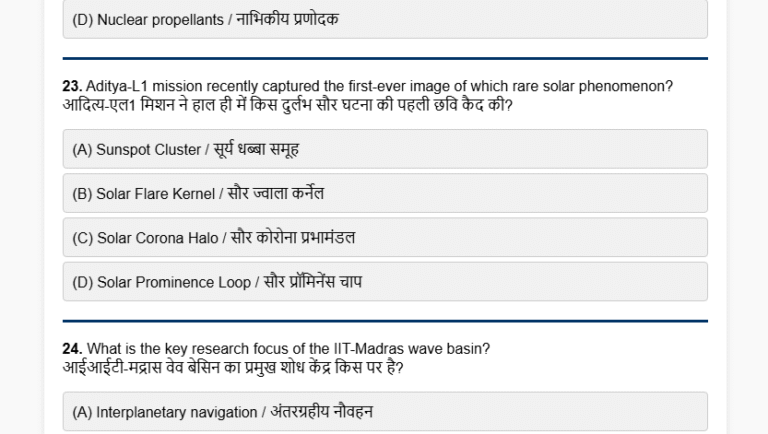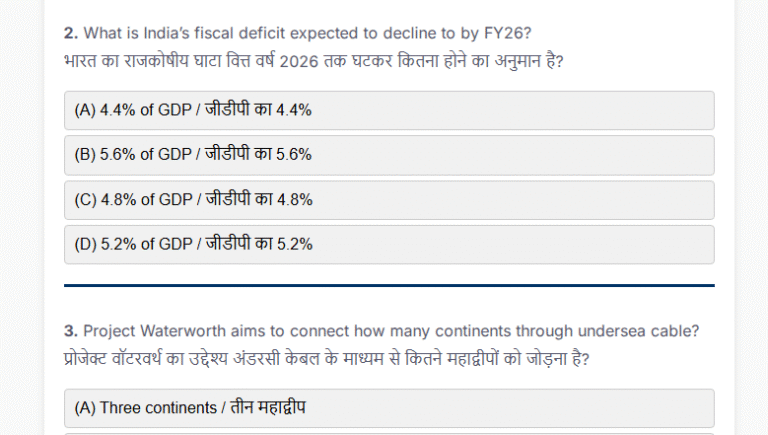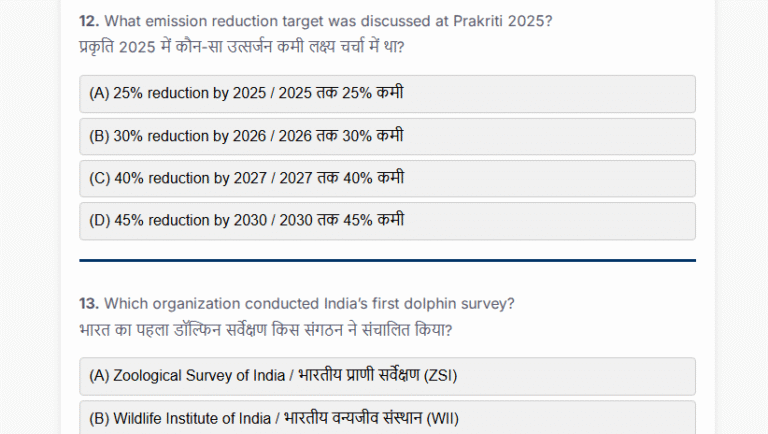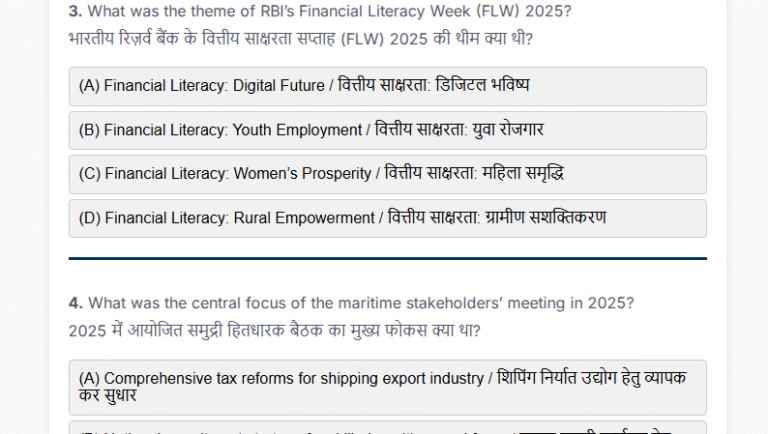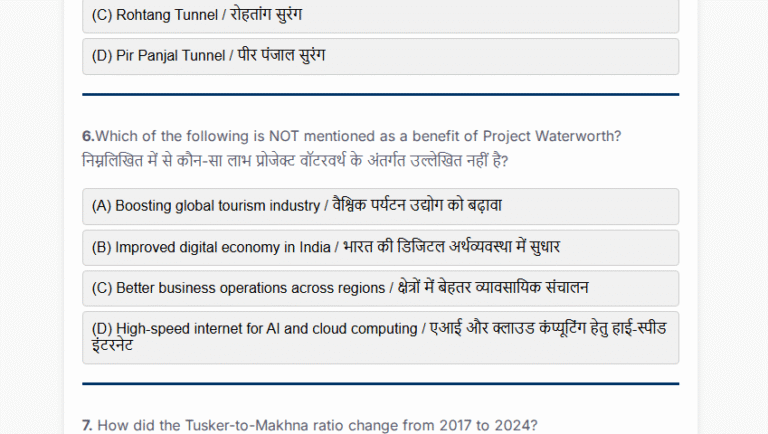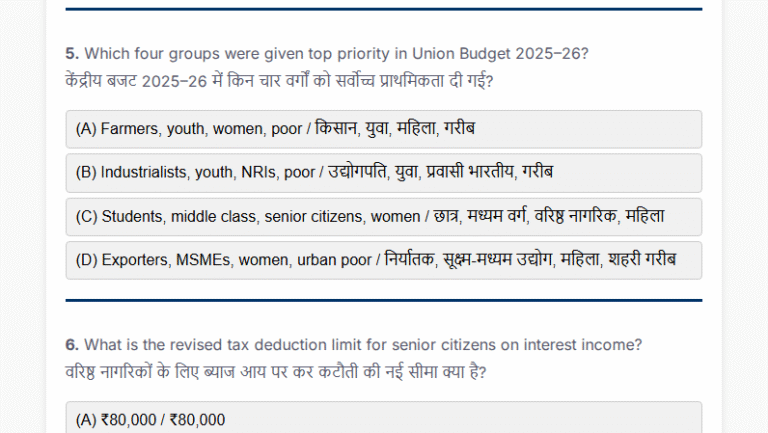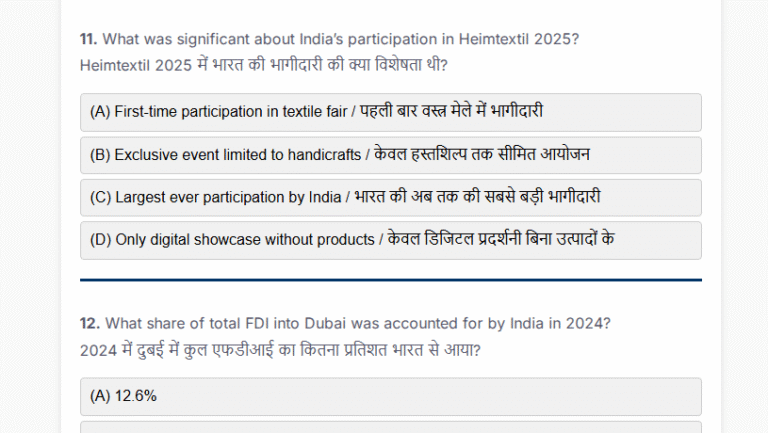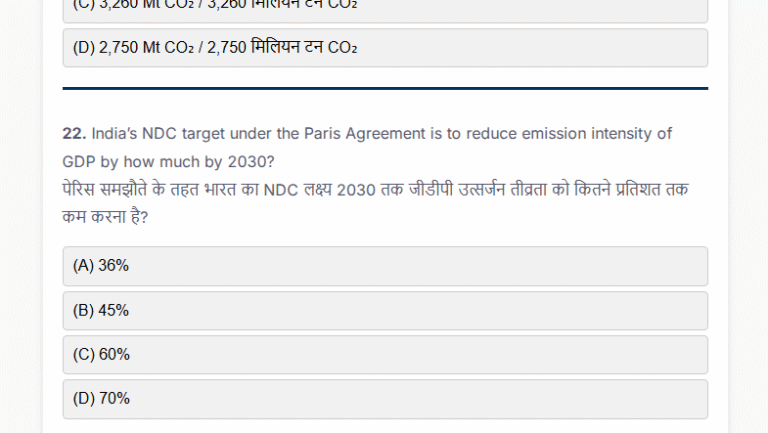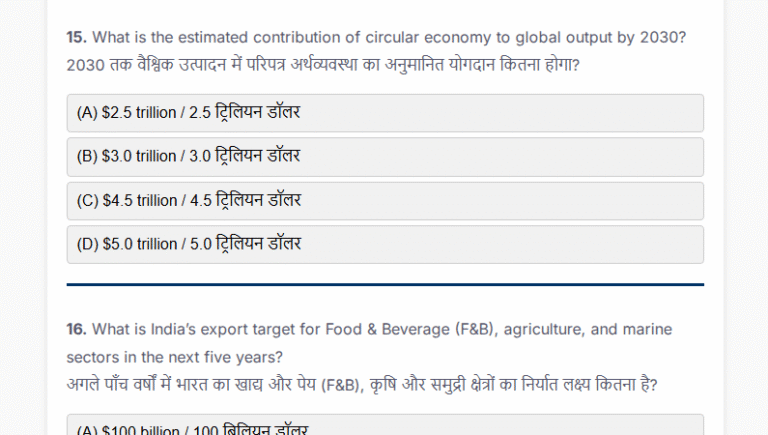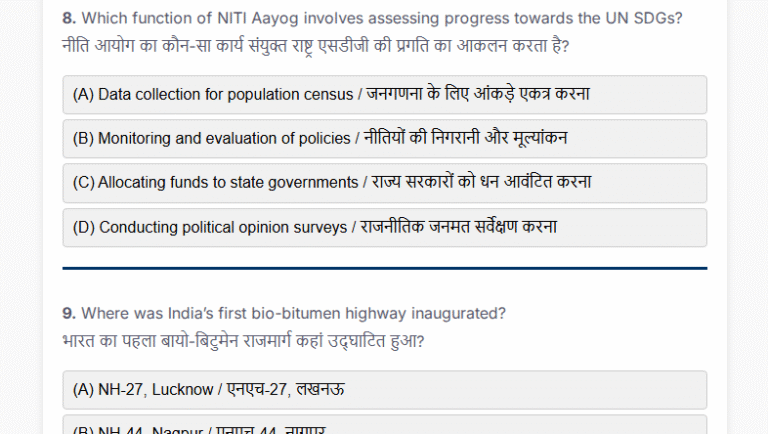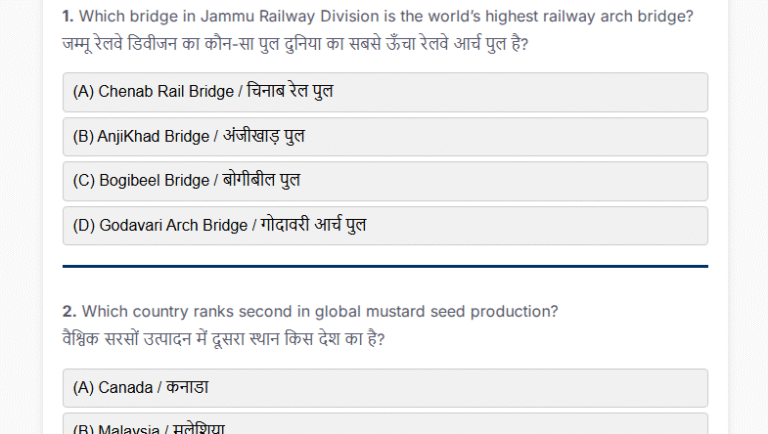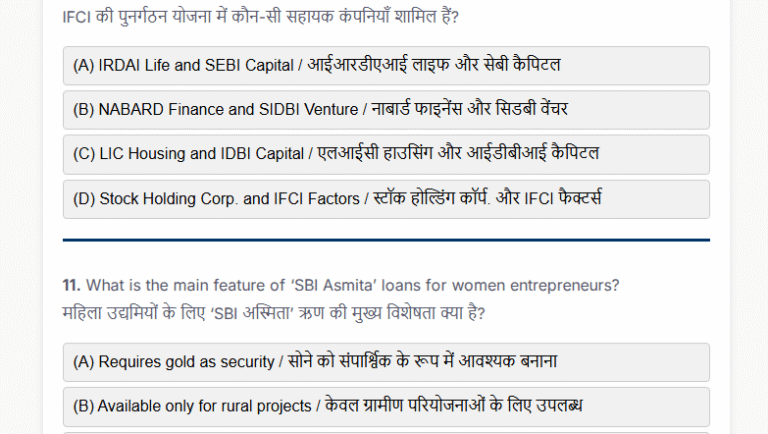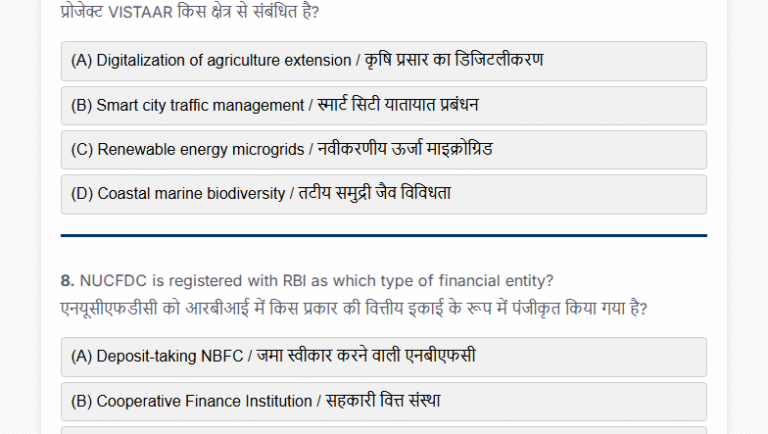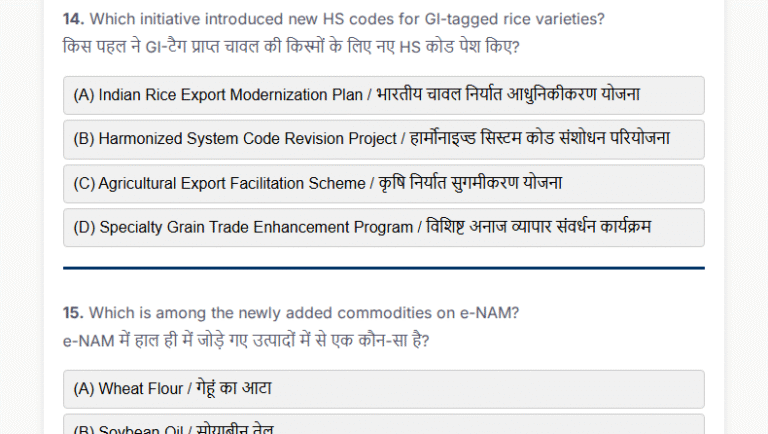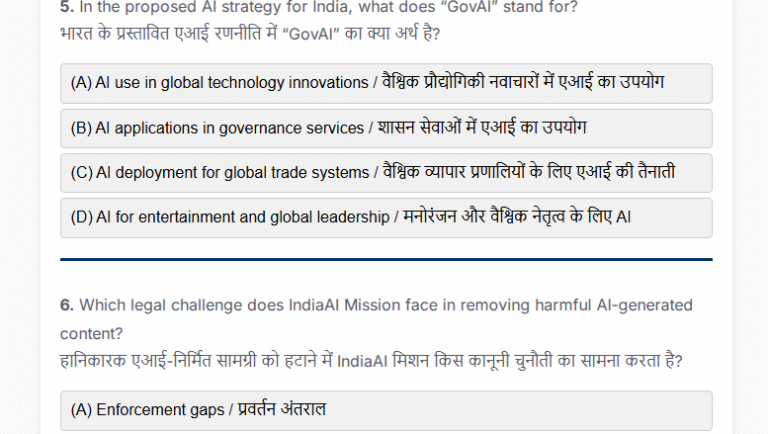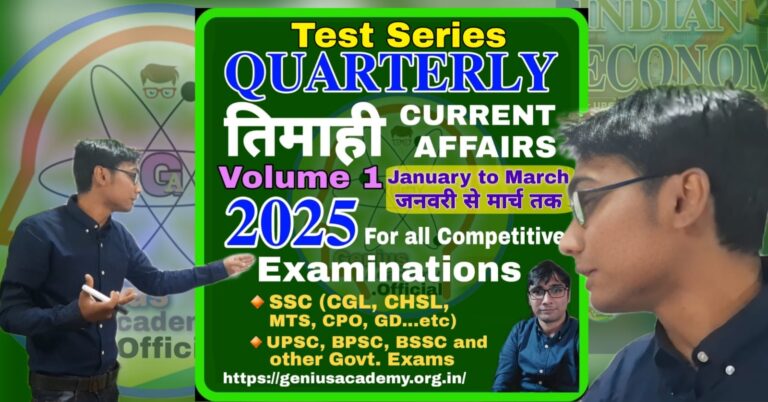Current Affairs Today MCQs (16 Nov 2024)
1. What is the primary objective of the tri-services Exercise ‘Poorvi Prahar’?
(A) To train personnel in desert warfare
(B) To maintain a formidable defense posture along India’s Eastern frontier
(C) To enhance naval capabilities in the Indian Ocean
(D) To test missile systems in the Western sector
The correct answer is (B) To maintain a formidable defense posture along India’s Eastern frontier
Exercise ‘Poorvi Prahar’ is a tri-services exercise led by the Indian Army, conducted in Arunachal Pradesh. It focuses on maintaining a robust defense posture along India’s Eastern frontier to ensure territorial integrity.
2. Which of the following assets is NOT a part of the ‘Poorvi Prahar’ exercise?
(A) Advanced Light Helicopter (Rudra)
(B) Swarm drones
(C) M777 Ultra-Light Howitzers
(D) Submarines
The correct answer is (D) Submarines
While ‘Poorvi Prahar’ includes assets like Rudra helicopters, swarm drones, and M777 Howitzers, submarines are not part of the exercise. The focus is on land, air, and sea coordination, but submarines are primarily used for maritime operations.
3. What capability does ‘Poorvi Prahar’ aim to reinforce?
(A) Naval dominance in the Indian Ocean
(B) Cybersecurity infrastructure
(C) Strategic deterrence in the Eastern sector
(D) Joint control with foreign forces
The correct answer is (C) Strategic deterrence in the Eastern sector
The exercise focuses on strengthening India’s strategic deterrence capabilities along the Eastern frontier. This involves multi-domain operations and integration of cutting-edge technologies.
4. What is the primary mission of the South Asian Telecommunication Regulators’ Council (SATRC)?
(A) To develop space communication systems
(B) To promote regional cooperation and harmonized telecom regulations
(C) To create 5G technology exclusively for South Asia
(D) To establish telecom trade agreements
The correct answer is (B) To promote regional cooperation and harmonized telecom regulations
SATRC’s mission is to enhance regional collaboration among South Asian countries and ensure harmonized telecom regulations. It was established to bridge the digital divide and promote ICT development.
5. What was the theme of the 25th SATRC meeting?
(A) ransforming Space Communication in Asia
(B) Promoting Digital Sovereignty in South Asia
(C) Advancing 5G Networks Across South Asia
(D) Accelerating Telecommunication and ICT Development for Growth and Inclusiveness
The correct answer is (D) Accelerating Telecommunication and ICT Development for Growth and Inclusiveness
The theme emphasized the role of telecommunication and ICT in driving economic and social progress in South Asia while ensuring inclusiveness in the digital ecosystem.
6. Which of the following countries is NOT a member of the SATRC?
(A) India
(B) Maldives
(C) Myanmar
(D) Afghanistan
The correct answer is (C) Myanmar
SSATRC includes nine South Asian countries: Afghanistan, Bangladesh, Bhutan, India, Iran, Maldives, Nepal, Pakistan, and Sri Lanka. Myanmar is not a member of this council.
7. Where is the headquarters of the Asia-Pacific Telecommunity (APT) located?
(A) New Delhi, India
(B) Bangkok, Thailand
(C) Kathmandu, Nepal
(D) Beijing, China
The correct answer is (B) Bangkok, Thailand
The APT, an international organization promoting ICT development in the Asia-Pacific region, has its headquarters in Bangkok, Thailand.
8. When was the South Asian Telecommunication Regulators’ Council (SATRC) established?
(A) 1979
(B) 1997
(C) 2001
(D) 2015
The correct answer is (B) 1997
SATRC was established in 1997 by the Asia-Pacific Telecommunity (APT) and the ITU Regional Office for Asia and the Pacific to harmonize telecom regulations in South Asia.
9. Which innovative technology is being integrated into ‘Poorvi Prahar’?
(A) Artificial Intelligence-powered naval ships
(B) Hypersonic missiles
(C) Space-based weaponry
(D) Swarm drones and loitering munitions
The correct answer is (D) Swarm drones and loitering munitions
Exercise ‘Poorvi Prahar’ incorporates advanced technologies like swarm drones and loitering munitions to enhance precision strikes, situational awareness, and operational flexibility.
10. What is the purpose of developing a Common Operating Picture (COP) in ‘Poorvi Prahar’?
(A) To enhance financial transparency
(B) To optimize coordination among the three forces
(C) To improve cyber defense capabilities
(D) To establish international partnerships
The correct answer is (B) To optimize coordination among the three forces
The COP in ‘Poorvi Prahar’ is developed through joint control structures to enable seamless integration and coordination among the Army, Navy, and Air Force.
11. How does the ‘Poorvi Prahar’ exercise help the Indian armed forces adapt to modern warfare?
(A) By focusing solely on cyberwarfare
(B) By exclusively training personnel for desert operations
(C) By testing new underwater submarines
(D) By integrating cutting-edge technologies for precision and coordination
The correct answer is (D) By integrating cutting-edge technologies for precision and coordination
The exercise focuses on enhancing adaptability in modern warfare by employing technologies like swarm drones, loitering munitions, and advanced joint control mechanisms. This ensures better situational awareness and operational efficiency.
12. Which of the following helicopters is used in ‘Poorvi Prahar’?
(A) Apache AH-64
(B) Chinook and Advanced Light Helicopter (Rudra)
(C) Black Hawk UH-60
(D) Kamov Ka-226
The correct answer is (B) Chinook and Advanced Light Helicopter (Rudra)
The Chinook and Rudra helicopters are part of the ‘Poorvi Prahar’ exercise. These platforms support reconnaissance, troop movement, and precision strikes, enhancing the exercise’s effectiveness in mountainous terrains like Arunachal Pradesh.
13. What is the duration of Exercise ‘Poorvi Prahar’ in 2024?
(A) November 1–7
(B) November 10–18
(C) November 15–20
(D) November 20–28
The correct answer is (B) November 10–18
Exercise ‘Poorvi Prahar’ is scheduled from November 10 to 18, 2024. This timeframe allows the tri-services to comprehensively test their interoperability and strategic capabilities along the Eastern frontier.
14. Which region’s strategic deterrence capability is strengthened through ‘Poorvi Prahar’?
(A) Western Sector
(B) Northern Sector
(C) Eastern Sector
(D) Central Sector
The correct answer is (C) Eastern Sector
The exercise is conducted in Arunachal Pradesh to bolster India’s defense posture in the Eastern sector, ensuring readiness to counter threats and secure the frontier.
15. What is a key focus area of SATRC in the telecommunications sector?
(A) Building military communications infrastructure
(B) Exclusively advancing space communication
(C) Restricting foreign investment in telecom
(D) Enhancing digital inclusiveness and reducing digital divides
The correct answer is (D) Enhancing digital inclusiveness and reducing digital divides
SATRC aims to promote digital inclusiveness across South Asia by addressing regulatory challenges and harmonizing telecommunications policies to ensure equitable ICT access for all.
16. When was the first meeting of the South Asian Telecommunication Regulators’ Council (SATRC) held?
(A) 1997
(B) 2000
(C) 2005
(D) 2010
The correct answer is (A) 1997
he first SATRC meeting took place in 1997 as part of its establishment by the Asia-Pacific Telecommunity (APT) and ITU to foster regional cooperation in telecommunications.
17. What is the primary goal of the Asia-Pacific Telecommunity (APT)?
(A) To regulate international internet standards
(B) To promote ICT development in the Asia-Pacific region
(C) To establish military communication networks
(D) To manage satellite launches in Asia
The correct answer is (B) To promote ICT development in the Asia-Pacific region
The APT, formed in 1979, focuses on fostering the growth of information and communication technologies in the Asia-Pacific region to drive regional development and connectivity.
18. Which South Asian country is a member of SATRC?
(A) Myanmar
(B) China
(C) Bangladesh
(D) Japan
The correct answer is (C) Bangladesh
Bangladesh is one of the nine South Asian countries that are members of SATRC, along with Afghanistan, Bhutan, India, Iran, Maldives, Nepal, Pakistan, and Sri Lanka.
19. What role do swarm drones play in the ‘Poorvi Prahar’ exercise?
(A) Testing underwater navigation
(B) Conducting medical evacuations
(C) Improving supply chain logistics
(D) Enhancing situational awareness and precision strikes
The correct answer is (D) Enhancing situational awareness and precision strikes
Swarm drones provide the capability to gather real-time data and execute coordinated precision strikes, making them invaluable for modern, multi-domain operations like those in ‘Poorvi Prahar’.
20. What was the central theme of the SATRC-25 meeting?
(A) Advancing 5G Networks Across Asia
(B) Accelerating Telecommunication and ICT Development for Growth and Inclusiveness
(C) Promoting Space Communication in South Asia
(D) Establishing Global Digital Trade Agreements
The correct answer is (B) Accelerating Telecommunication and ICT Development for Growth and Inclusiveness
The SATRC-25 meeting emphasized ICT development to promote economic and social inclusiveness, with a focus on bridging the digital divide across South Asia.
_
Set 20 Quarterly CA 2025 Jan to March IMPORTANT INSTRUCTIONS This test consists of 25 questions.At…
Set 19 Quarterly CA 2025 Jan to March IMPORTANT INSTRUCTIONS This test consists of 25 questions.At…
Set 18 Quarterly CA 2025 Jan to March IMPORTANT INSTRUCTIONS This test consists of 25 questions.At…
Set 17 Quarterly CA 2025 Jan to March IMPORTANT INSTRUCTIONS This test consists of 25 questions.At…
Set 16 Quarterly CA 2025 Jan to March IMPORTANT INSTRUCTIONS This test consists of 25 questions.At…
Set 15 Quarterly CA 2025 Jan to March IMPORTANT INSTRUCTIONS This test consists of 25 questions.At…
Set 14 Quarterly CA 2025 Jan to March IMPORTANT INSTRUCTIONS This test consists of 25 questions.At…
Set 13 Quarterly CA 2025 Jan to March IMPORTANT INSTRUCTIONS This test consists of 25 questions.At…
Set 12 Quarterly CA 2025 Jan to March IMPORTANT INSTRUCTIONS This test consists of 25 questions.At…
Set 11 Quarterly CA 2025 Jan to March IMPORTANT INSTRUCTIONS This test consists of 25 questions.At…
Set 10 Quarterly CA 2025 Jan to March IMPORTANT INSTRUCTIONS This test consists of 25 questions.At…
Set 9 Quarterly CA 2025 Jan to March IMPORTANT INSTRUCTIONS This test consists of 25 questions.At…
Set 8 Quarterly CA 2025 Jan to March IMPORTANT INSTRUCTIONS This test consists of 25 questions.At…
Set 7 Quarterly CA 2025 Jan to March IMPORTANT INSTRUCTIONS This test consists of 25 questions.At…
Set 6 Quarterly CA 2025 Jan to March IMPORTANT INSTRUCTIONS This test consists of 25 questions.At…
Set 5 Quarterly CA 2025 Jan to March IMPORTANT INSTRUCTIONS This test consists of 25 questions.At…
Set 4 Quarterly CA 2025 Jan to March IMPORTANT INSTRUCTIONS This test consists of 25 questions.At…
Set 2 Quarterly CA 2025 Jan to March IMPORTANT INSTRUCTIONS This test consists of 25 questions.At…
Set 3 Quarterly CA 2025 Jan to March IMPORTANT INSTRUCTIONS This test consists of 25 questions.At…
Test Series of 1st Quarterly Current Affairs 2025 प्रथम त्रैमासिक करेंट अफेयर्स 2025 की टेस्ट सीरीज़…
Current Affairs Today MCQs (26 Nov 2024) 1. What is the primary purpose of the Rejang Dewa dance in…
Current Affairs Today MCQs (25 Nov 2024) 1. What feature distinguishes African penguins from other…
Current Affairs Today MCQs (24 Nov 2024) 1. Which of the following is a distinctive feature of…
Current Affairs Today MCQs (23 Nov 2024) 1. What is the target adaptation finance commitment for the…
Current Affairs Today MCQs (22 Nov 2024) 1. How many youth are targeted for internships under the PM…
Current Affairs Today MCQs (21 Nov 2024) 1. Which is the funding ratio for PM-JAY between the Centre…
Current Affairs Today MCQs (20 Nov 2024) 1. Who is eligible for the Ayushman Vay Vandana Card? (A)…
Current Affairs Today MCQs (5 Nov 2024) 1. What conditions contribute to the formation of the DANA…
Current Affairs Today MCQs (4 Nov 2024) 1. What is the primary function of Israel’s Iron Beam…
Current Affairs Today MCQs (3 Nov 2024) 1. To whom was the Balfour Declaration addressed? (A) David…


